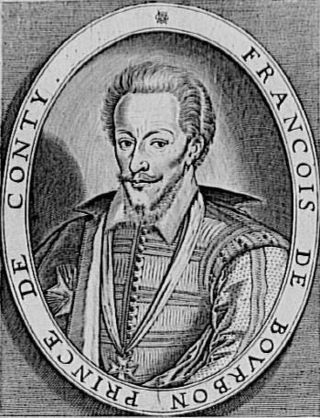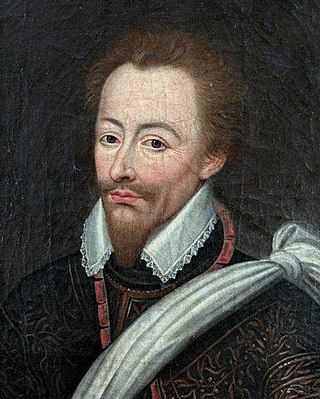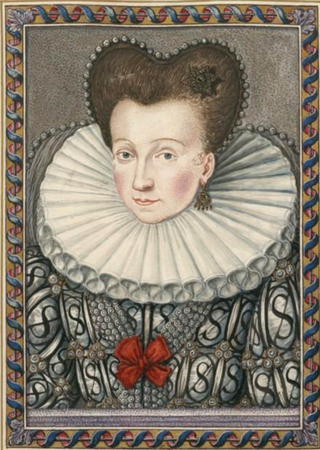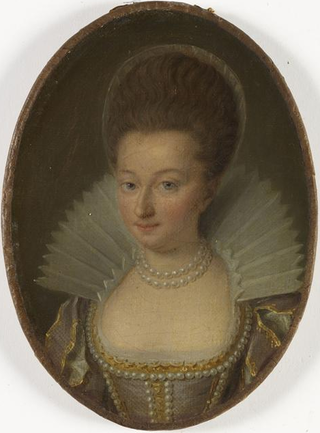
The House of Bourbon is a dynasty that originated in the Kingdom of France as a branch of the Capetian dynasty, the royal House of France. Bourbon kings first ruled France and Navarre in the 16th century. A branch descended from the French Bourbons came to rule Spain in the 18th century and is the current Spanish royal family. Further branches, descended from the Spanish Bourbons, held thrones in Naples, Sicily, and Parma. Today, Spain and Luxembourg have monarchs of the House of Bourbon. The royal Bourbons originated in 1272, when Robert, the youngest son of King Louis IX of France, married the heiress of the lordship of Bourbon. The house continued for three centuries as a cadet branch, serving as nobles under the direct Capetian and Valois kings.

François de Bourbon, Prince of Conti was the third son of Louis de Bourbon, Prince of Condé, a junior line of the House of Bourbon, and his first wife Eléanor de Roucy de Roye. He was given the title of Marquis of Conti and between 1581 and 1597 was elevated to the rank of a prince. The title of Prince of Conti was honorary and did not carry any territorial jurisdiction.

Henri de Bourbon, 2nd Prince of Condé was a French prince du sang and Huguenot general like his more prominent father, Louis I, Prince of Condé.

Duke of Bourbon is a title in the peerage of France. It was created in the first half of the 14th century for the eldest son of Robert of France, Count of Clermont, and Beatrice of Burgundy, heiress of the lordship of Bourbon. In 1416, with the death of John of Valois, the Dukes of Bourbon were simultaneously Dukes of Auvergne.

Henri II de Bourbon, Prince of Condé was the head of the senior-most cadet branch of the House of Bourbon for nearly all his life and heir presumptive to the King of France for the first few years of his life. Henri was the father of Louis, le Grand Condé, the celebrated French general.
Count of Guise and Duke of Guise were titles in the French nobility.

Charles de Bourbon, Cardinal de Bourbon, Archbishop of Rouen was a French noble, prelate and disputed King of France as the Catholic Ligue candidate from 2 August 1589 – 9 May 1590. Born the third son of Charles of Bourbon, Duke of Vendôme and Françoise d'Alençon he was destined for a career in the church. As a member of the House of Bourbon-Vendôme he was one of the premier Prince du sang. Already having secured several sees, he was made a Cardinal by Pope Paul III in January 1548. In 1550 he received the office of Archbishop of Rouen making him the Primate of Normandy. The following year the promotion of Bourbon to Patriarch of the French church was threatened by King Henry II to secure concessions from the Pope. During the Italian Wars which resumed that year, Bourbon played a role by supporting Catherine de Medici's regency governments in France and briefly holding a lieutenant-generalship in Picardy. In 1557 the Pope appointed the Cardinals Bourbon, Lorraine and Châtillon as the leaders of an inquisition in France to root out heresy. The effectiveness of their inquisition would be obstructed by both the king and the Parlements and by July 1558 their appointments were voided by the Parlement of Paris.

Catherine of Bourbon was a Navarrese princess regent. She was the daughter of Queen Jeanne d'Albret and King Antoine of Navarre. She ruled the principality of Béarn in the name of her brother, King Henry III of Navarre, from 1576 until 1596.

Anna Gonzaga was an Italian French noblewoman and salonist. The youngest daughter of Charles Gonzaga, Duke of Mantua and Montferrat, and Catherine de Mayenne, Anna was "Princess Palatine" as the wife of Edward of the Palatinate, a grandson of King James I of England and uncle to King George I of Great Britain. She bore Edward three children, all daughters. Had Anna not converted Edward to Catholicism, the English throne might have passed to their descendants.

Catherine of Cleves, Countess of Eu was the wife of Henry I, Duke of Guise and the matriarch of the powerful and influential House of Guise. By marriage, she was Duchess of Guise from 1570 to 1588, and Dowager Duchess of Guise thereafter. She was also Countess of Eu in her own right from 1564.

Françoise d'Alençon was the eldest daughter of René of Alençon and Margaret of Lorraine, and the younger sister and despoiled heiress of Charles IV, Duke of Alençon.

A prince du sang or prince of the blood is a person legitimately descended in male line from a sovereign. The female equivalent is princess of the blood, being applied to the daughter of a prince of the blood. The most prominent examples include members of the French royal line, but the term prince of the blood has been used in other families more generally, for example among the British royal family and when referring to the Shinnōke in Japan.

Françoise d'Orléans-Longueville, Princess of Condé was the second wife of Louis de Bourbon, Prince of Condé, a "Prince du Sang" and leader of the Huguenots during the French Wars of Religion.

Henriette de La Marck, also known as Henriette of Cleves, was a French noblewoman and courtier. She was the 4th Duchess of Nevers, suo jure Countess of Rethel, and Princess of Mantua by her marriage with Louis I of Gonzaga-Nevers. A very talented landowner, she was one of France's chief creditors until her death.

Jeanne d'Albret, also known as Jeanne III, was Queen of Navarre from 1555 to 1572.

Charlotte Catherine de La Trémoïlle was a French noblewoman and, by marriage, Princess of Condé. By birth she belonged to the House of La Trémoïlle.

Louise Marguerite of Lorraine, Princess of Conti was a daughter of the Duke of Guise and a member of the House of Lorraine. She married François de Bourbon, titled the Prince of Conti. As such, after her marriage she was the Princess of Conti. She died without any surviving issue.

Catherine-Marie de Lorraine, Duchess of Montpensier, was a French princess from the house of Guise who played a leading political role in the Catholic League during the French Wars of Religion.

















